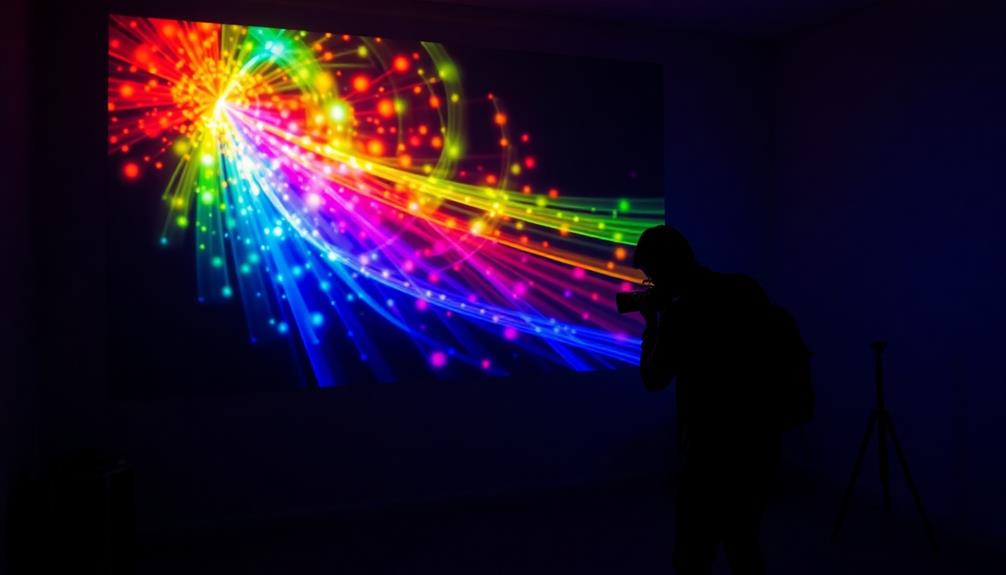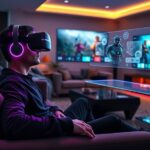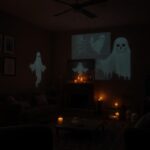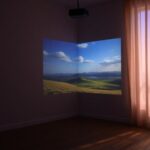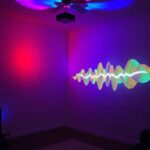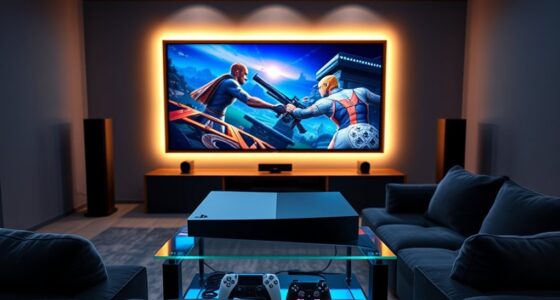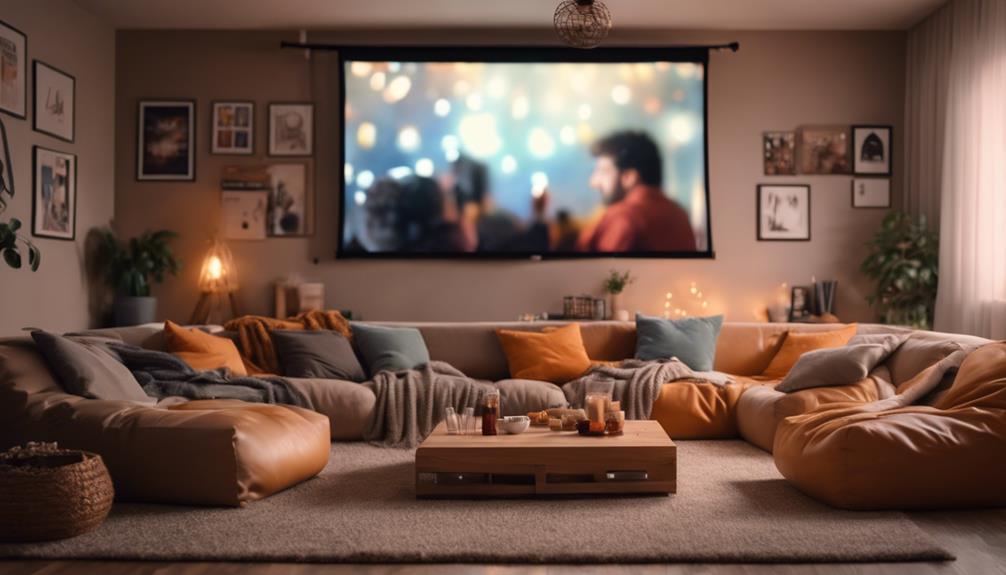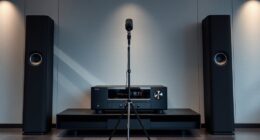You can easily create a thrilling home escape room by incorporating projector puzzles. Start by choosing an enchanting theme and storyline to engage players. Use short-throw projectors to display dynamic visuals and clues on various surfaces, enhancing immersion and interaction. Arrange your puzzles logically to guarantee a smooth flow, and consider using projection mapping to turn everyday objects into interactive elements. Make sure to test the projector setup for clarity and adjust lighting accordingly. This approach creates a unique experience that fascinates and challenges. Want to discover even more tips and tricks for your home escape room setup?
Key Takeaways
- Choose an engaging theme and storyline to enhance player immersion and enjoyment throughout the escape room experience.
- Utilize short-throw projectors to create dynamic visuals and puzzles that adapt to player actions, enhancing interaction with the environment.
- Strategically place projectors to display clues on various surfaces, ensuring they integrate seamlessly into the room's design and atmosphere.
- Incorporate diverse puzzle types and nonlinear designs to maintain excitement and encourage teamwork among participants.
- Test and iterate your escape room setup to refine puzzles and ensure a smooth, engaging gameplay experience for all players.
The Power of Projection
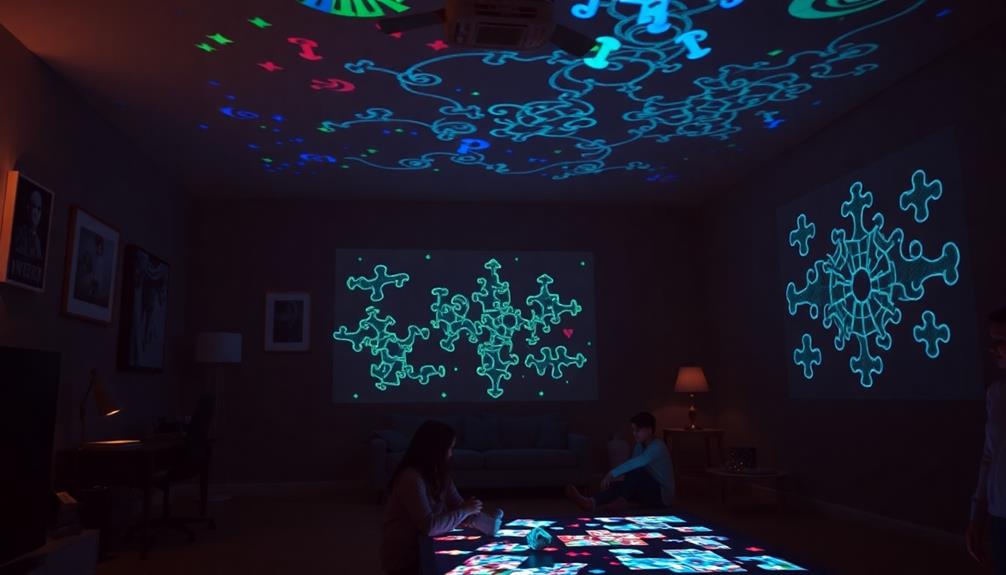
Transforming your home into an escape room can be a thrilling experience, and leveraging the power of projection is key to enhancing that adventure. By utilizing projection mapping technology, you can create dynamic visuals that captivate players, enriching the narrative and thematic elements of your puzzle-solving adventure.
Imagine hints and hidden clues appearing seamlessly within the gameplay area, keeping players engaged and maintaining the game flow.
Short-throw projectors are perfect for small spaces, allowing you to project large images without disrupting the action. You can easily transform ordinary objects into interactive elements, making the escape room feel alive.
Dynamic visuals can simulate natural phenomena, like flickering fire or swirling blizzards, which not only enhance atmosphere but also immerse players further into the experience.
The magic of projection lies in its ability to surprise and delight. With carefully crafted projections, you can create moments of wonder that elevate your escape room from a simple game to an unforgettable adventure.
Designing Your Escape Room
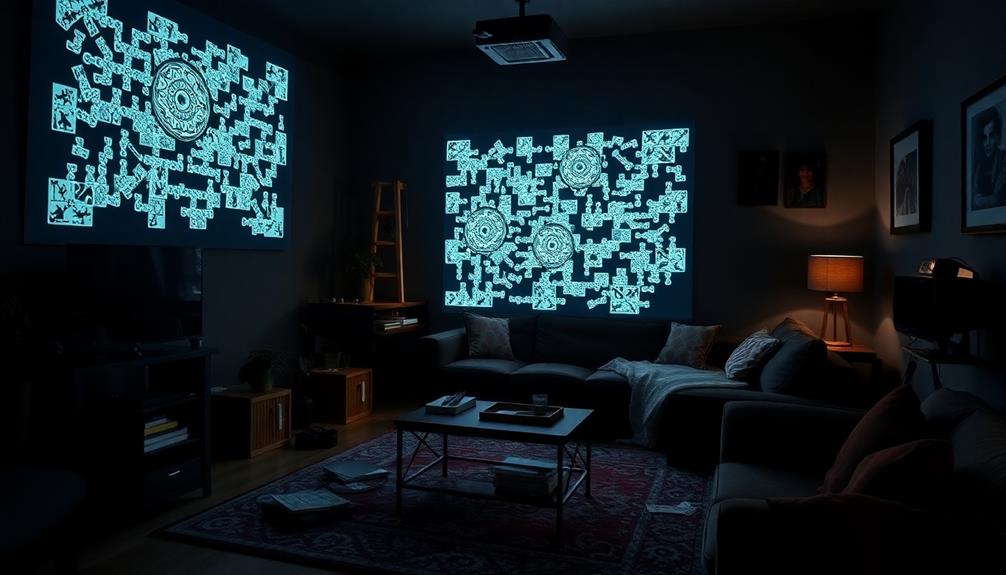
When designing your escape room, start by choosing an intriguing theme and storyline that draws players in.
Next, think about how to arrange your puzzles to create a logical flow, ensuring everyone can enjoy the experience.
Balancing different types of challenges will keep participants engaged and enthusiastic to solve the mystery.
Theme Selection Strategies
Selecting the right theme for your escape room is vital to creating an engaging and immersive experience. Begin by choosing escape room themes that resonate with your interests and those of your participants, like horror, adventure, or mystery. This connection boosts engagement and makes the experience more enjoyable.
Additionally, consider how the theme might influence the space optimization strategies you'd employ, similar to those used in tiny house planning. Incorporate storytelling elements to craft a compelling narrative that sets the tone, encouraging players to invest emotionally in their journey. Use projection mapping technology to enhance the atmosphere, transforming physical elements into dynamic visuals that align with your theme.
Consider seasonal themes, such as Halloween or Christmas, to add unique twists that make your escape room feel timely and relevant, increasing participant enthusiasm.
It's essential to guarantee that all puzzles and clues are designed to fit the selected theme, creating a cohesive environment that supports the narrative. This alignment not only enhances the immersive experience but also boosts player satisfaction as they solve challenges.
Puzzle Arrangement Techniques
Once you've chosen your theme, the next step is to arrange the puzzles effectively to enhance the overall experience. To create an enthralling escape room, organize your puzzles in a logical sequence that aligns with your storyline. This guarantees a coherent game flow and keeps players engaged from start to finish.
Incorporating mindfulness practices can help you design puzzles that resonate with players' emotions, enhancing their connection to the experience and boosting their overall enjoyment, leading to improved emotional well-being as they play emotional well-being.
Utilize a game flow chart to visualize how each clue builds upon the last, helping players understand their progression and boosting their satisfaction as they solve puzzles. Incorporate different types of puzzles—like logic challenges, riddles, and physical tasks—to cater to various thinking styles and maintain dynamic gameplay.
Consider nonlinear game design by allowing multiple puzzles to be solved simultaneously. This gives players the freedom to choose their paths and minimizes bottlenecks, making the escape room experience more enjoyable.
Lastly, conduct a trial run to test the arrangement of puzzles. This will help you identify any issues with difficulty or flow, allowing you to make necessary adjustments.
Incorporating Projected Clues
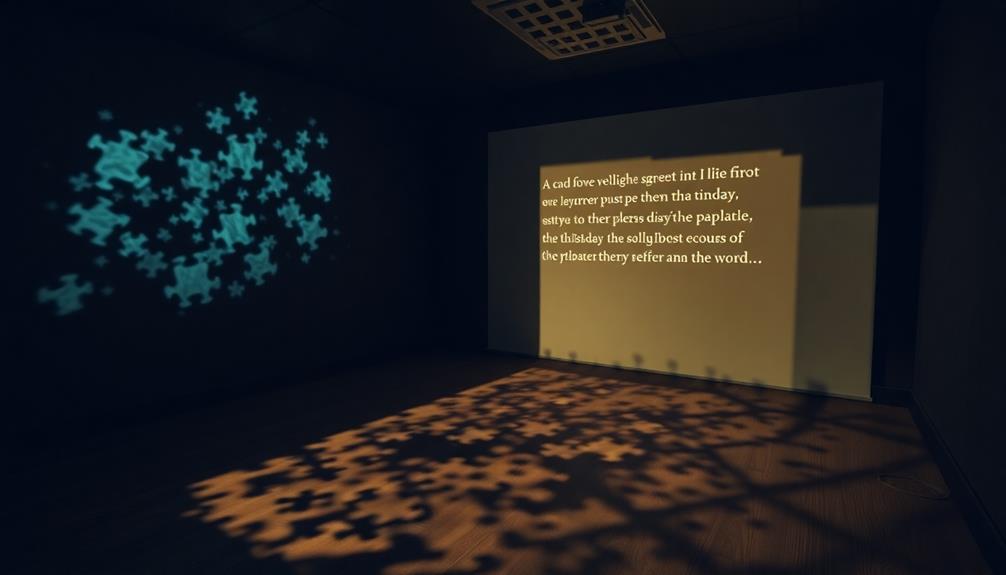
When you incorporate projected clues into your escape room, think about where to place your projectors for maximum effect.
Selecting a projector with high refresh rates can enhance the clarity of your projected clues, making them easier for players to discern.
You can create a dynamic clue presentation that not only captures attention but also seamlessly integrates with your room's design.
Projector Placement Techniques
Positioning projectors effectively is essential for creating an intriguing home escape room experience. Use short-throw and ultra short-throw projectors to minimize interference in compact spaces. This guarantees clear visibility of projected clues without obstructing gameplay.
Strategically place pico projectors to create surprising moments, allowing clues to blend seamlessly with the physical environment. Consider utilizing unconventional display surfaces, like mirrors or fog, to project clues in unique ways that enhance the immersive experience. These creative techniques can surprise participants and keep them on their toes.
By using multiple projectors, you can distribute hints across various locations in the room, keeping players engaged in the gameplay without diverting their attention to a central screen. Make sure the projected clues can be easily removed or altered as needed, maintaining the room's dynamic nature.
This flexibility allows you to keep players focused on the current challenges while introducing hidden clues and interactive elements. With careful attention to projector placement techniques, you'll guarantee your home escape room is both intriguing and memorable, making the adventure all the more thrilling for everyone involved.
Dynamic Clue Presentation
Building on effective projector placement techniques, dynamic clue presentation can elevate your home escape room experience. By using projectors to display clues directly onto the playing surface, you create an immersive experience that keeps players focused on the game instead of looking back at a central monitor.
Utilizing multiple projectors allows you to distribute clues throughout the room, encouraging exploration and engagement with the environment.
With dynamic clue presentation, you can easily remove or change clues during gameplay, facilitating a fluid game experience that adapts to player progress. Creative techniques like projection mapping can turn everyday objects into interactive clue sources, enhancing the puzzle-solving experience. Imagine a book that suddenly reveals a hidden message when illuminated—a twist that keeps players on their toes.
Incorporating dynamic lighting effects through projectors can simulate atmospheric elements like flickering shadows or eerie glows, further enriching your storytelling. This approach not only enhances the overall ambiance but also creates an engaging environment that fascinates players' imaginations.
Embrace the power of projection technology, and transform your home escape room into a fascinating adventure that challenges and delights all who enter.
Enhancing Immersion With Visuals
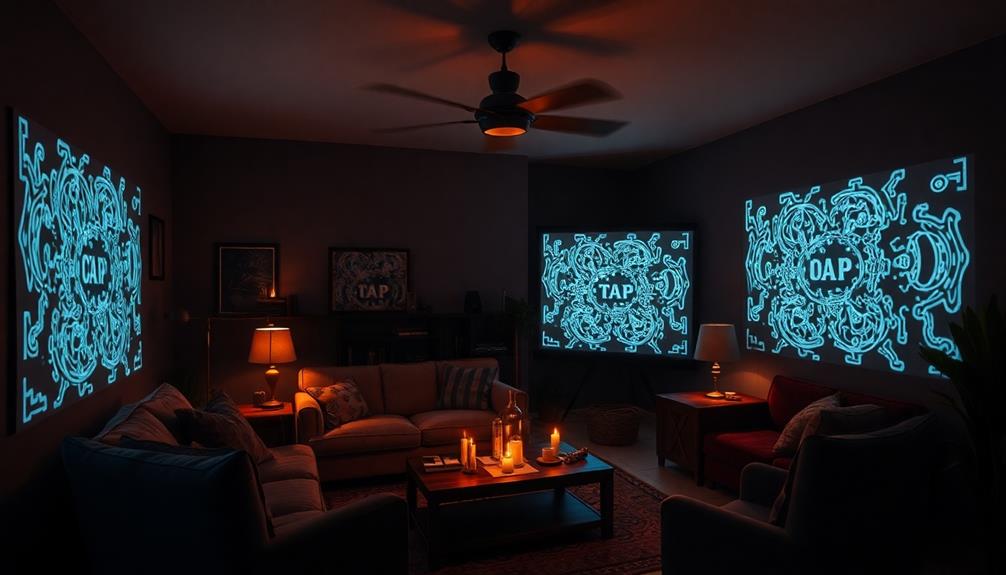
Immersion in a home escape room can be dramatically enhanced through the creative use of visuals. By utilizing projection mapping technology, you can transform ordinary objects into dynamic visuals that appear, move, and vanish, elevating the immersive experience. This not only captivates players but also deepens their engagement with the environment.
Imagine hidden clues projected directly onto surfaces, seamlessly integrating with the story, and keeping players focused on the adventure.
Short-throw projectors are ideal for compact spaces, allowing you to produce large images without the risk of interference. This means you can create a thematic atmosphere that feels expansive, even in a small room.
Incorporating dynamic lighting effects through projectors can simulate natural phenomena like fire or blizzards, enriching the storytelling elements of your escape room.
As you design your escape room, think about how these visuals can enhance player engagement and create a cohesive narrative.
Choosing the Right Projector

Selecting the right projector is essential for creating an engaging home escape room experience. Consider short-throw or ultra short-throw projectors to minimize space requirements and avoid gameplay interference. These projectors allow you to project large images from a short distance, making them perfect for compact areas.
If you're looking for versatility, a portable projector like the Kodak Luma 350 can work wonders. Despite its small size, it can create impressive visuals, fitting seamlessly into unique placements within your escape room.
Make certain the projector has high brightness, measured in lumens, to guarantee it performs well under various lighting conditions, especially if you plan to use dynamic lighting effects.
Don't overlook the importance of connectivity options. Look for projectors that offer HDMI or wireless capabilities to facilitate seamless integration with other technology, enhancing your projector puzzles and overall setup.
Additionally, consider project projection mapping capabilities; this feature can transform physical items in the room into different visuals, markedly boosting the immersive experience.
Setting Up the Space

After you've chosen the right projector, it's time to focus on setting up the space for your home escape room. Start by clearing out distractions—remove non-game objects to enhance the immersive environment. This creates a dedicated area where players can fully engage in the escape room experience without interruptions.
Next, utilize creative display surfaces. Think about using mirrors or cabinets to maximize the impact of projected visuals, adding surprising elements to the gameplay. Arrange furniture thoughtfully; confirm you have ample space for movement so players don't feel cramped as they navigate through challenges.
Finally, choose appropriate lighting settings that complement your projected visuals. The right atmosphere can elevate your escape room experience dramatically.
Here's a quick overview of key elements to reflect upon:
| Element | Importance |
|---|---|
| Clear out distractions | Enhances immersion |
| Arrange furniture | Facilitates movement |
| Creative surfaces | Maximize visual effects |
| Lighting settings | Sets the mood and atmosphere |
With these steps, you'll create an engaging space that captivates players and transports them into your unique escape room adventure.
Engaging Players With Puzzles

Creating an engaging puzzle experience in your home escape room can transform the gameplay into something truly memorable. By incorporating projected images, you can create dynamic puzzles that adapt to player actions, enhancing the overall experience.
Imagine hidden clues appearing on walls or surfaces as players explore the room, seamlessly integrating hints into gameplay without the distraction of traditional screens.
Utilizing projection mapping technology, you can turn ordinary objects into interactive puzzle elements, creating surprising visual effects that captivate everyone's attention. Clues can be scattered around your escape room with several projectors, encouraging exploration and teamwork as players work together to uncover hints.
This collaborative effort fosters a sense of community, making the game more enjoyable.
Moreover, using pico projectors allows for creative placements even in small spaces, enabling innovative puzzle designs. You could reveal clues on unique surfaces like mirrors or fog, adding an extra layer of intrigue.
Tips for a Smooth Experience

Smooth gameplay is essential for an enjoyable home escape room experience. To achieve this, you need to focus on several key aspects of your projector setup, guaranteeing that the projected hints and visuals enhance the game rather than hinder it.
Here are three tips to guarantee a smooth experience:
- Test your projector setup: Before the game, set up your projector and test it for clarity and visibility. Adjust brightness and contrast settings to account for varying lighting conditions so that your dynamic visuals remain clear and engaging throughout.
- Utilize short-throw or pico projectors: These projectors can create immersive experiences without taking up too much space. This allows players to move freely while still enjoying projected hints and clues that enhance the overall atmosphere.
- Incorporate projection mapping: Transform everyday objects into engaging visual puzzles or clues. By designating specific areas for projected hints, you maintain immersion, allowing players to focus on solving puzzles without distractions from screens.
Testing and Iterating Your Game

To guarantee your home escape room is a hit, thorough testing and iteration are crucial steps in the process. Start by organizing a full playtest with friends or family. This will help you identify any confusing puzzles or unclear instructions. During the playtest, gather feedback from participants to understand their experiences and make necessary adjustments.
| Aspect | Key Considerations |
|---|---|
| Puzzles | Are they challenging but fair? |
| Feedback | What do participants find confusing? |
| Timing | Does the experience fit your desired time limit? |
| Adjustments | What changes can enhance flow? |
Iterate on your game by running multiple rounds of testing. Focus on refining the difficulty levels of your puzzles to guarantee they're engaging without being frustrating. Pay close attention to the timing of each segment to maintain a consistent pace throughout the experience. Document all changes made based on feedback and testing outcomes. This will help you track the evolution of your escape room, guaranteeing that improvements are effectively integrated into the final design.
Frequently Asked Questions
How to Make Your Own Escape Room Puzzles?
To make your own escape room puzzles, start with a central theme, then design clues that logically lead to the solution. Incorporate various puzzle types and test them for balance and engagement with friends.
How Do You Make an Escape Room Experience?
To craft an escape room experience, you're weaving a tale where players become heroes. They'll solve puzzles, reveal secrets, and journey through challenges, all while the clock ticks down, heightening the suspense and excitement.
What Kind of Puzzles Do You Solve in an Escape Room?
In an escape room, you'll solve a mix of puzzles, like logic challenges that test your reasoning, physical tasks requiring manipulation, language-based riddles, cryptic codes to decode, and collaborative puzzles demanding teamwork and communication.
How Do You Make a Good Digital Escape Room?
Crafting a digital escape room is like weaving a spell; you must blend engaging puzzles, interactive visuals, and immersive audio. Keep players guessing with clues that seamlessly integrate technology, ensuring an unforgettable experience they won't forget.
Conclusion
As you wrap up your escape room experience, remember: the thrill doesn't end when the last clue is solved. What if there's a hidden element you haven't considered? A final twist that could leave your players guessing? By continually testing and iterating, you'll reveal new layers of excitement. So, gather your friends, dim the lights, and prepare for a night filled with mystery and surprise. The real adventure might just be waiting in the shadows.

